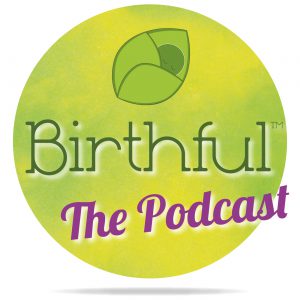
Birthful: Episode 50 – Family-Centred Cesareans
Why this podcast?
With over a hundred episodes covering a huge range of pregnancy, birth and postpartum topics, this podcast is a great one to return to again and again.
The host, Adriana Lozada, is warm, bubbly and so enthusiastic that as well as being packed with great info each episode is also really entertaining to listen to.
Adriana is not only the host of this podcast but also a birth doula, postpartum educator, writer and author.
The Birthful Podcast aims to “inform your intuition” and does so by interviewing experts on subjects such as high-risk pregnancy, milk sharing, loving your postpartum body, birth stories, your baby’s microbiome, green pregnancy, prenatal bonding and your baby mammal to name just a few.

How does it look?
New episodes are released each week and last around an hour.
For all of the ins and outs of this podcast please check out this post from a few weeks ago featuring a fantastic episode on doulas –
Why this episode?
”If you don’t know your options then you don’t have any”
(Diana Korte & Roberta Scaer)
As a doula, I firmly believe that knowing your options and being involved in all of the decisions around your birth play a major role in having a positive birth experience.
Whether you are planning a C-section or whether your birth ends up being a C-section, you still have options.
You still have choices.
It is still your birth.
A cesarean does not have to be a cold, detached process in which you play no part.
Who should listen to this episode?
Wait for it….. yes, everyone! Pregnant women and partners alike.
Even if your birth plan is aimed at avoiding a cesarean, planning for one means that in the unlikely event you actually need one, you will still play a central role in how your birth experience unfolds.
The episode
Dr Pamela Berens is the featured guest on this episode and her bio is extensive. An OB/GYN who is active in clinical practice as well as being involved in medical student and resident education, Dr Berens’ main areas of focus are on pregnancy, postpartum care, breastfeeding and breastfeeding complications.
About ten years ago she started to listen to women undergoing cesareans who wanted immediate skin to skin with their babies.
This was the start of her experience with what would later be called family-centred or gentle cesareans.

Why does the type of cesarean you have matter?
Dr Berens began to notice that women who gave birth via cesarean often felt disconnected from their birth experience and would often have to wait for much longer than women who gave birth vaginally to hold and bond with their babies.
But, what if it doesn’t have to be this way?
What if there were little tweaks that could be made to the cesarean process to make the whole experience a much more intimate one for women and their babies?
Well, the good news, as you may have guessed, is that there is.
What can you change about a major surgical procedure?
Clearly, a cesarean is major abdominal surgery and certain things, like maintaining a sterile area, have to be adhered to but there are aspects that can be altered.
IV Placement
Changing the location of the IV needle so that the tubes do not interfere with the mother holding her baby is such a small thing but can make such a big difference.

Heart sensor placement
On a similar note, placing the sensors somewhere other than on the mother’s chest means that the baby can go straight to the mother for skin to skin and can initiate breastfeeding whenever they feel like it.
Optimal cord clamping
Dr Berens talks about waiting for between sixty and ninety seconds before clamping and cutting the cord. Although the cord could still be pulsating, this time frame is in line with the World Health Organisation’s guidelines.
Waiting a little longer is possible but waiting too much longer is difficult as the baby can get cold.
As soon as the cord is cut the baby can go to the mother for skin to skin to keep their body temperature at a good level.
Skin to skin
In a traditional cesarean the baby is generally shown briefly to the parents before being taken to the warmer to be checked. In a family-centred cesarean the baby can go directly to the mother for skin to skin and any checks can be carried out there.
Skin to skin has been shown to have numerous benefits for both mother and baby, including:
– Improved breastfeeding rates
– Less anxiety in the mother
– Babies who are less likely to cry &
– Babies who are more likely to maintain stable heart rates, breathing and temperatures.
Apgar assessments
Providing the baby is doing well there should be no reason to separate them from their mother.
Any observations can be carried out whilst the baby is skin to skin on the mother’s chest.

Breastfeeding
Being skin to skin can make beginning and continuing the breastfeeding relationship easier for both mother and baby.
Keeping mum and baby warm
Operating rooms can be colder than a standard hospital room and Dr Berens and her team worked hard to come up with some creative ways to address this.
They warmed the IV fluids. They placed a heating device on the mother’s arms and chest so that when the baby came to her she was better able to help her baby keep warm.
This shows that with a little creativity and willingness a procedure that could so easily feel detached and clinical can be transformed into a warm, wonderful experience.
Help holding your baby
Some women feel nauseous or shakey after surgery and so, apart from a nurse who is dedicated to keeping an eye on the mother and who can support her in holding her baby, Dr Berens also mentions that there are various garments that a woman can wear to help support her in holding her newborn.

Music
Having your own choice of music playing in the background can help make the whole process feel much more personal and allows you to choose music that you know will help you feel relaxed.
Lighting
I had read about the possibility of dimming the lights in the operating room during a gentle cesarean but Dr Berens pointed out that whilst the light she, as a surgeon, needed, would shine directly on the mother’s abdomen and not in her eyes, the anesthesiologist would need very good light to be able to observe the mother and the various machines.
A cesarean is major abdominal surgery and surgery carries inherent risks that the surgical staff have to look out for.
I would imagine that different hospitals and even different medical staff would have varying policies on changing the lighting in an operating room so if this is something that is important to you make sure you discuss it well in advance.
Helping to deliver your baby
I recently saw this series of photos showing a mother helping to guide and lift her baby from her abdomen during a family-centred cesarean.
I was waiting for this concept to be discussed during the podcast but was disappointed when it did not come up.
I later contacted the host, Adriana, who confirmed that she and Dr Berens had not discussed this subject. Adriana also pointed out that a mother helping to deliver her baby during a cesarean would mean the mother moving her hands and arms into the sterile area.
If this is something you would like to include in a possible cesarean it is vital that you discuss it well in advance of the birth. Whether or not it is permitted will vary greatly from place to place and person to person.
To wrap up
Your birth experience can have such an impact on both you and your family that it is incredibly important to plan for the birth you want.
Occasionally, birth surprises us and takes some unexpected turns. That is why planning for the possibility of a cesarean, even if you are not aiming for one, could mean that you emerge from your experience having had the amazing, warm, intimate birth that you planned for.
And that’s huge.
–
I am so inspired by the concept of gentle cesareans. If you have experienced one or are planning for one please leave a comment.
What aspects do or did you want to include or avoid?
How supportive is/was your care provider?
What does having a gentle cesarean mean to you?
Other episodes on this topic
Dr Stu’s Podcast: Episode 88 – A kinder, gentler cesarean
Motherlove – Family-centred cesarean
The fear free childbirth podcast – Cath’s Gentle C-Section Birth
A really informative video showing a gentle cesarean
Emily Wills is a doula based in Stockholm. She believes that birth can be a beautiful and empowering experience and started this blog as a way of sharing some really great podcasts. She is also a mother of three and an enthusiastic runner.
